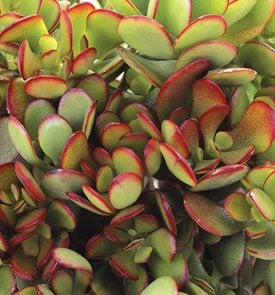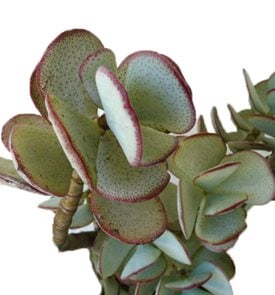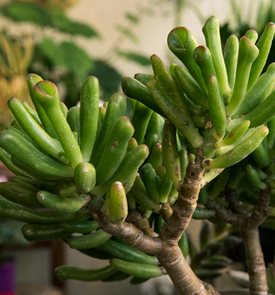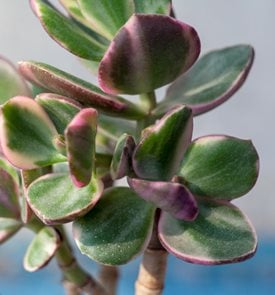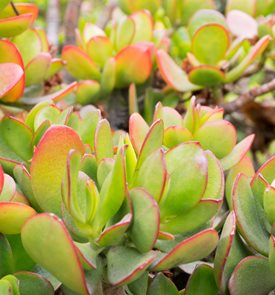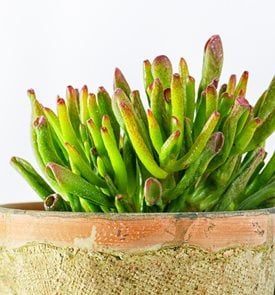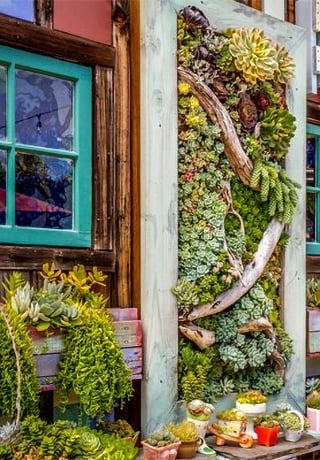A GUIDE TO GROWING JADE PLANT
Bring good luck into your home with these popular easy-to-grow succulent plants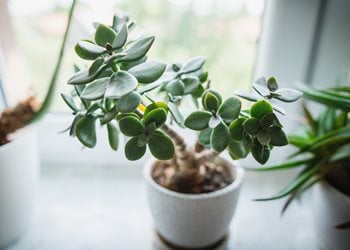
Photo by: Vellicos / Shutterstock
Succulents have enjoyed a resurgence in popularity in recent years, with houseplants being no exception. Jade plant (Crassula ovata) has long been a favorite of houseplant enthusiasts for its round fleshy leaves, distinct tree-like form, and undemanding nature.
Also known as lucky plant, money plant or money tree, jade plant signifies luck, prosperity and friendship in many Asian cultures. It’s considered good feng shui to keep a jade plant by the front door to welcome money into the home. These revered plants are often given as housewarming or congratulatory gifts.
Though jade plant is grown primarily as a houseplant, it will also thrive outdoors as an evergreen perennial shrub in warmer regions. Learn how to grow these easy-care plants and explore different varieties here.
On this page: Basics | Growing Tips | Care and Maintenance | Problems and Solutions | Jade Plant Pictures | Display Ideas
- JADE PLANT BASICS
- GROWING TIPS
- JADE PLANT CARE
- TROUBLESHOOTING JADE PLANT PROBLEMS
- TYPES OF JADE PLANTS
- DISPLAY IDEAS
BASICS
Botanical name:
Crassula spp.
Origin:
Native to South Africa and Mozambique
Hardiness:
Zones 9-12, depending on the species
Light:
Jade plant grows best in a mix of direct sun and bright indirect light for best vigor and foliage color. Allow at least 4-6 hours of direct sun, providing protection during the hottest part of the day to prevent leaf burn. If growing jade plants indoors, place them in a south or east-facing window that receives at least 4 hours of bright light. Jade plant is somewhat tolerant of lower light levels.
Growth rate:
Slow
Habit/Size:
Upright or mounding habit, 3 to 12 feet tall and 2 to 6 feet wide. Houseplants stay smaller.
Foliage:
Thick fleshy leaves can be round, oval, irregular or crinkled, occurring in colors of green, gold, silver-blue and variegated, often with red or burgundy highlights.
Flowers:
Clusters of tiny star-shaped white or pale pink flowers bloom from winter to early spring, with some varieties blooming later. Flowers only occur on indoor specimens if they get enough light.
Toxicity:
Jade plants are mildly toxic to humans, causing nausea if ingested and mild skin irritation for sensitive individuals. All parts of the plant are mildly to highly toxic to cats, dogs, and horses.
GROWING JADE PLANTS
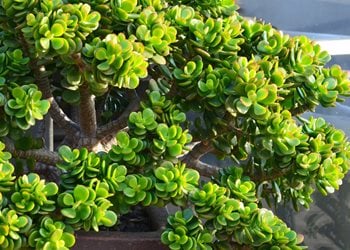
Jade plant growing outdoors. Photo by: svf74 / Shutterstock.
Where to grow:
Jade plants can be grown indoors as houseplants, or outside year-round in warmer regions. Houseplants benefit from being moved outdoors in summer, responding to the additional sunlight and warmer weather with increased vigor, growth, and color. Move to an area such as a patio or porch that receives some direct sun, acclimating slowly to prevent shock and foliage burn. Bring back indoors in fall when nighttime temperatures drop to 50 degrees F.
Temperature and humidity:
Though they prefer dry conditions, jade plants are tolerant of higher humidity. Ideal indoor temperature range is 65-75 degrees F, with nighttime temperatures down to 55 degrees F. Avoid extremes, which can stress or kill plants.
Soil type:
Jade plants need good drainage to prevent root rot. They will tolerate native soils that are rocky or sandy. For houseplants or outdoor containers, use a cactus or succulent potting mix and add an equal amount of pumice or perlite to improve drainage. Jade plants prefer a neutral to slightly acidic soil pH, but are tolerant of different pH levels.
Pot requirements:
Make sure pots have adequate drainage. Terracotta clay pots are more porous, allowing soil to dry out quicker, which helps prevent root rot. If using ceramic or plastic pots, make sure there is adequate drainage and water less frequently. Larger specimens, which can become top heavy, will need heavier pots to keep them from tipping over.
Propagation:
Jade plant is easily propagated through stem or leaf cuttings. Stem propagation tends to be quicker and with a higher rate of success. Propagate during warmer months and use cuttings that are healthy and disease-free.
- For stem cuttings: With a clean sharp knife, cut a stem a few inches long just above a leaf node. Remove lower leaves and allow the cut end to dry and form a callous. Small white roots will begin to develop after several weeks. Dip the rooted end in rooting hormone and place in a small pot or tray with a mix of equal parts perlite and potting soil. Water sparingly. Once roots are established, treat as you would a normal jade plant.
- For leaf cuttings: With a clean sharp knife, snip off individual leaves flush to the stem. Allow to dry for up to several weeks. When small white roots develop, the leaf will begin to shrivel and turn brown. Place the roots in a mix of equal parts perlite and potting soil. Water sparingly until you see a tiny new stem and leaf emerge. When plants reach several inches tall, treat as you would a normal jade plant.
JADE PLANT CARE
Care level:
Easy
Watering:
Jade plants die far more often to overwatering than underwatering. Their fleshy leaves act as a water reservoir. Water thoroughly and allow to dry out completely in-between watering. Water every 7 to 14 days, more frequently in summer when the weather is warmer. Reduce watering in fall and winter when plants enter a period of semi-dormancy.
Fertilizing:
Jade plants are light feeders. Apply a mild all-purpose organic fertilizer in early to mid-spring when plants are coming out of semi-dormancy. Fertilize at half-strength every 1 to 2 months during the growing season.
Pruning:
Plants can be allowed to retain their natural shape or pruned into bonsai. Because jade plants store water in their leaves, older plants can become top heavy and unable to support the extra weight, so will benefit from pruning.
Wait until plants are at least a year old before pruning. The best time to prune is spring to early summer, when plants begin a new growth spurt. Because pruning can leave plants susceptible to disease, make sure pruning tools are sterile, and prune sparingly. Tools should be sharp to prevent tissue damage.
Avoid cutting the main trunk, which can severely damage or kill the plant. Cut drooping branches back to the trunk to encourage more robust growth. Thin branches as needed to increase the amount of light and air circulation. To shape, trim any errant branches just above a leaf node. Cut branches can be propagated into new plants.
Cleaning:
Wipe leaves with a damp cloth every few months to keep foliage looking fresh.
Repotting:
Jade plants are slow growing and prefer to be somewhat pot bound. They will only need occasional repotting, every 2 to 3 years for younger plants and 4 to 5 years for mature specimens. Repot in spring when plants are beginning a new growth spurt and use a new pot that is only slightly larger.
Pests:
The most common pests found on jade plant are mealybugs. Other pests can include aphids, spider mites, or scale. Rinse foliage with water to remove most of the pests. Allow to dry, then wipe leaves with a cotton ball or swab dipped in 70% rubbing alcohol to kill remaining pests. Repeat as needed. The use of horticultural oils and insecticides is not recommended.
TROUBLESHOOTING JADE PLANT PROBLEMS
Jade plants have few insect, disease, or cultural problems when grown in the right conditions. Here are some things to look for:
Leaf spots, wrinkled, shriveled or dropped leaves can be an indication of underwatering. Water plants thoroughly and allow to dry out completely in between waterings.
Soft squishy leaves are a symptom of overwatering, which can lead to other problems such as root rot. Reduce watering and allow soil to dry out completely in between waterings.
Stunted or leggy plants are an indication of not enough light. Place plants in a window that gets at least several hours of direct sunlight or use grow lights.
Black rings on the underside of leaves are a sign of black ring disease. This virus does not kill plants and there is no effective treatment. Remove affected leaves and dispose in the garbage to prevent virus spread. Don’t propagate affected leaves.
Yellow or pale green leaves can occur when a plant is overgrown. Remove sickly, scraggly and crossing branches back to the trunk so the plant can put energy back into rejuvenation.
White spots on leaves can indicate excess salt, overwatering, powdery mildew or mealy bugs. Identify the problem and treat accordingly.
Blisters that appear on lower leaves or dropped leaves can be a sign of root rot, which can kill plants. Reduce watering and make sure pots have adequate drainage. Add extra sand or perlite to soil to improve drainage.
Brown and mushy plant tissue can be a symptom of bacterial soft rot, which can cause plants to collapse and die. Even though only part of the plant may look infected, it is best to get rid of the whole plant.
Scabby areas on leaves or a dusty white coating can be a sign of powdery mildew. Apply a fungicide or home remedy made from baking soda, apple cider vinegar, or milk. Make sure plants receive adequate light and air circulation, and don’t overwater.
Dark spots on foliage can be a sign of fungal disease. Treat with a fungicide or home remedy. Make sure plants receive adequate light and air circulation, and don’t overwater.
Droopy leaves can be an indication that plants have been exposed to cold temperatures. Bring into warmer conditions and watch to see if branches revive. Cut off any foliage that doesn’t recover.
TYPES OF JADE PLANTS
DISPLAY IDEAS
- Plant in a rock garden with other succulents, cacti, and alpines.
- A bonsai specimen makes a sophisticated focal point in a living room or bedroom.
- Combine on a tabletop or shelf with other houseplants that have contrasting forms, foliage, and coloring for a captivating display.
- Display alongside other Crassulas such as ‘Ivory Towers’ (C. x perforata), jade necklace vine (C. ruprestris ssp. marnieriana) or campfire plant (C. capitella).
- Plant several small specimens in miniature ceramic pots of differing bright colors and display side by side on a shelf for a chic modern look.
RELATED:
The Best Indoor Plants for Any Purpose
15 Popular Types of Succulents

